One of the best places in the Arboretum to visit in late winter is the Winter Garden, where there is almost always something colorful and in bloom. Today, we discuss the hellebores – which also have the common names of lenten rose and Christmas rose – those plants of the genus Helleborus, which mostly bloom in the late-winter and early-spring months.
Hellebores are Buttercups!?
Well, not exactly. Genus Helleborus are not really buttercups (genus Ranunculus), but they are both members of the buttercup family – otherwise known as the Ranunculaceae. The hellebores share many features with the buttercups but differ in that the hellebores have pistils that are comprised of carpels with several ovules each and have fruits that are dry follicles. In contrast, Ranunculus have pistils with only 1 ovule each, which mature into achenes. The genus name of Helleborus comes from Greek “helein” for injures or destroys and “bora” for food, which is a reference to the plant’s leaves, stems and root being toxic and poisonous to humans if ingested.
Family Ranunculaceae
This family not only includes the hellebores and buttercups but also includes other well-known plants such as columbines (Aquilegia), larkspurs (Delphinium), meadow rue (Thalictrum) and clematis. Most members of this family have the following shared characteristics:
- Usually herbaceous
- Leaves simple, usually alternate arrangement, often deeply lobed or compound
- Flowers that are radially symmetrical (Delphinium is an exception to this)
- Flowers are bisexual (having both stamens and pistils) with its parts spirally arranged
- Sepals and petals are usually in 5s (or multiples of 5), many stamens, superior ovary with few-to-many separate carpels
The Hellebores
Genus Helleborus can be identified by the following traits:
- Herbaceous perennials
- Leaves mostly from the base, often with long petioles, palmately divided to compound
- Flowers large, solitary to several
- Sepals 5, petaloid and showy, white-green, yellow to red or purple in color
- Petals are small and tubular (often modified into nectaries), inconspicuous, usually shorter than stamens
- Many stamens
- Pistils 3-10, sessile, maturing into follicles
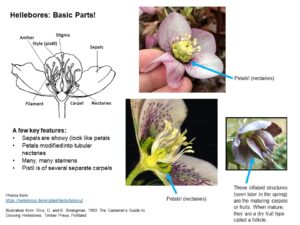

At the Arboretum, we have hellebores only in the Winter Garden, and they can be distinguished from one another mainly by the size, color, and shape of its blooms (showy sepals, not petals!), by their degree of leaf lobing, and by close examination of their stems (i.e., are there aboveground stems, are they branched, and are there leaves/bracts arising from those stems).
A few notable characteristics for each of our hellebores:
Lenten rose (Helleborus orientalis):
- Leaves and flowering stalks only lasting winter to late spring
- Leaves all basal, deeply palmately-lobed
- Flowers 2 to 4 per stem, saucer-shaped
- Showy sepals can be yellowish-green, white with purple-spots, to dark purple in color
- Stems and flowering stalks often branched
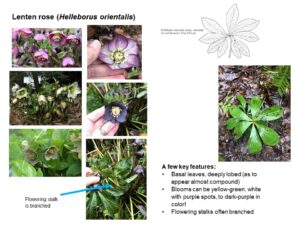

Christmas rose (Helleborus niger):
- Leaves and flowering stalks only lasting winter to late spring
- Flowers usually solitary
- Showy sepals can be bright-white to pale-purple in color
- Flowering stalks usually unbranched, bearing small leaves
- Basal leaves deeply palmately-divided
Helleborus niger ‘Jacob’:
This cultivar is the same species as the Christmas rose (H. niger), but has been selected to have large, single, pristine white flowers, that turn rose-pink in color as the flower ages. I am not sure how exactly to tell the difference between the straight species of H. niger with this named cultivar, but according to our internal database, we have both. This named cultivar has the same identification traits as H. niger.
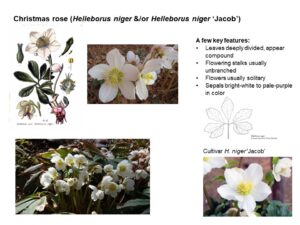

Stinking hellebore (Helleborus foetidus):
- Leaves and stems evergreen (lasting 1+ year), stems with leaves
- Leaves deeply palmately-lobed, edges with short teeth
- Flowering stalks with many flowers
- Flowers small, 1-3 cm across, cup- or bowl-shaped
- Sepals yellowish-green in color, usually tinged with purple
- The plants themselves do not stink (fetid aroma?), but there is an ‘earthy’ aroma if the plants are crushed or bruised.
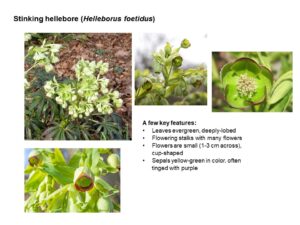

Unknown Hellebore – Helleborus ‘Cotton Candy’?
And lastly, there is a mystery hellebore in the Winter Garden! It does not look like the others, and although likely planted there by a previous curator or horticulturalist, this plant was not documented in our database. What is it? Just looking at its overall growth form, leaves, flowering stalks, and flowers (mostly looking at its sepal numbers and color), I am guessing that it may be the cultivar Helleborus ‘Cotton Candy’. According to several online plant nursery websites, this cultivar has glossy, deep-green foliage, and light-pink flowers which are double flowers. This means that its showy flower parts – sepals in this case – have twice (or more, in multiples) the typical number of parts. Note also that when there are multiple flower parts, it no longer has petals modified into nectaries. There are a few other possibilities that this white-pink flowered one could be too – Helleborus x hybridus – but too many potential cultivar options to name here.
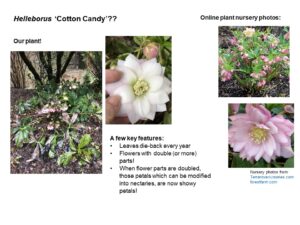

To wrap up, the next time you visit the Winter Garden and if the hellebores are blooming, see if you can find all four (or five?) of them. As of this writing (early March 2021), there are only two currently in bloom. Take a closer look at their flowers (especially the Helleborus orientalis), see if you can find the small, greenish petals which have been modified into nectaries located between the showy sepals and many stamens, and just admire their color, variation and beauty!
About the Author


References:
Bailey, L.H. 1949. Manual of Cultivated Plants. The MacMillan Company, New York.
Stace, C. 2010. New Flora of the British Isles, 3rd edition. Cambridge University Press, Cambridge.
Photos from:
Mike Drewery & M. Tu
https://helleborus.de/en/plant-facts/botany/
Illustration from:
Rice, G. and E. Strangman. 1993. The Gardener‘s Guide to Growing Hellebores, Timber Press, Portland.
